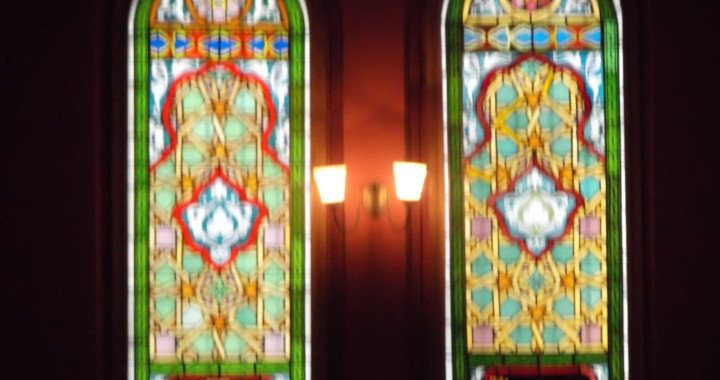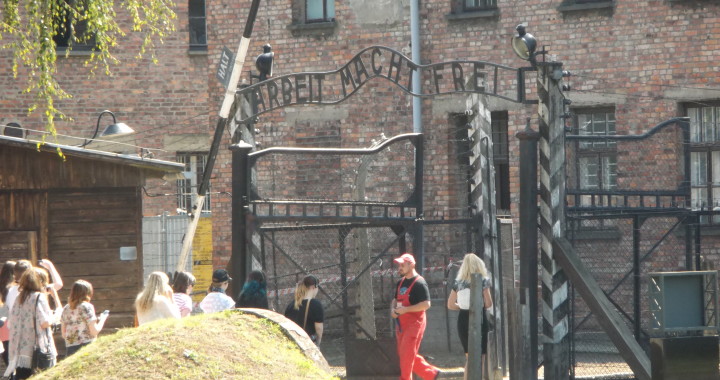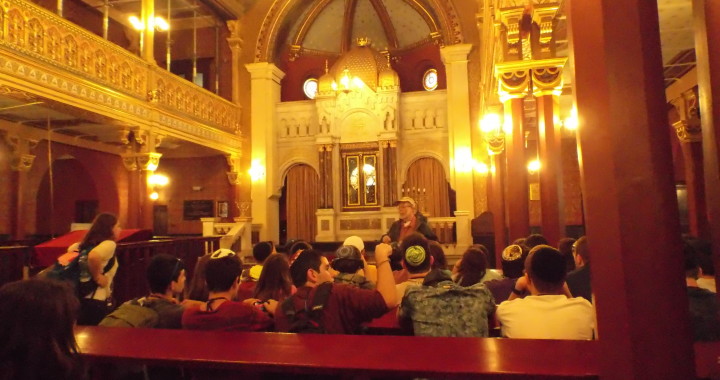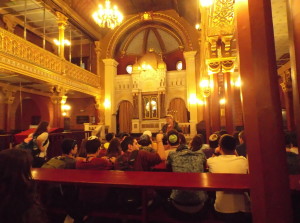If I had had USY experiences like this, I would have done more USY.
Shabbat this weekend was simply amazing, and it was a much needed reminder that while the Nazis may have killed many of our children, Judaism and passion for Jewish music and t’fillah is not lost in this generation, but in fact it’s thriving.
We started shabbat with a spirited and harmony filled Kabbalat Shabbat and Ma’ariv, followed by a delicious dinner. After dinner, we moved into a circle and sang z’mirot, or Jewish songs for a solid half hour or more. This group of USYers love to sing, and do so at every possible opportunity.
Saturday morning, we attending synagogue at the Temple Shul, where the Jewish culture festival had brought in three cantors from Israel to lead services in this beautiful Shul. It was an interesting, orthodox style service, where there was little singing and much davening. A choir came out for Musaf, which was pretty cool and sounded great. You don’t get to daven at that old of a synagogue with that much history too often, so it was definitely worth the experience. After lunch, we walked back to the hotel and had extended minucha, or rest time.
We ended shabbos with some pirkei avot study, Mincha, dinner (where I told the story of Moshele Gut Shabbos), ruach singing, Ma’ariv, and a spirited havdallah.
It’s extremely refreshing after working with younger kids for so long, and with kids who may not be as knowledgeable Jewishly, to be with a group of young Jewish leaders. Week one is over, and I can’t wait for 4 more in Israel.
Tag Archives: Poland
Never Forget
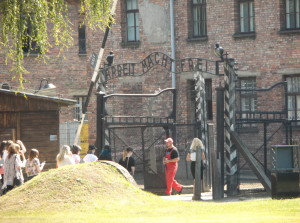
At perhaps the most well known of all concentration camps, Auschwitz – Birkenau was perhaps the most impactful of our experiences in Poland. We started the day at Auschwitz I, which was as much of a museum as it was a complete picture of what life was like there. Entering through the iconic gates that say “work will set you free”, we saw exhibits detailing the vast distances people were transported to get to the camp, as well as a picture of the different bunking conditions throughout the camp’s history (in case you were wondering, inmates started out sleeping on straw, which were later “upgraded” to mats, and eventually bunks, which were still extremely overcrowded).
We entered the new Jewish building, which focused on the lives of individual Jews before and during the war. The first room was filled with projections on the walls filled with videos, many homemade, of Jews with their families and friends. Upstairs, we entered the propaganda room, which displayed speeches from various Reich leaders translated on a series of screens demonizing the Jewish people. The next room was a simple design, with real children’s artwork drawn like pencil sketches on white walls from pre-war times. It was heartbreaking to imagine all of the young lives lost, and the potential they had to change the world wasted. The last room was the hall of names, where they had listed in a giant book like display the known names of 4 million+ that perished in the holocaust.
As we left the building, our guide Jules so poignantly stated, “When Jews arrived at Auschwitz, their names were replaced by numbers. It’s exhibits like this, and people like you, that give those who perished their names back.”
Birkenau was another experience entirely. This enormous death and labor camp, which had 4 crematorium, is quickly deteriorating to the point that if preservation measures aren’t enacted soon, any remaining structures may be reduced to rubble as many structures already have.
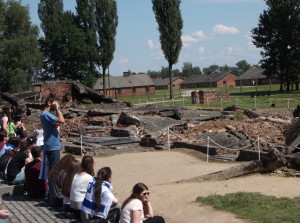
We grow up learning about the holocaust, and are told to never forget, but it’s not until the fragility of human life and remnants of the holocaust are experienced can we really gain an understanding for the importance and urgency of holocaust education.
We must teach. We must experience. We must teach the value of human life to our children. And we must never forget.
Synagogues, Synagogues, Synagogues
Thursday was a day filled with travel and synagogues. We started our day by traveling to the Temple Synagogue in Krasnik, where we davened shacharit in the old, run down synagogue.
After a moving service where we brought Judaism back to a town where there were no Jews left, we headed on a 4 hour drive to Krakow. On the ride, we watched the moving movie Schindler’s List, which recounts the heroics of Oskar Schindler, a Nazi who saved the lives of some 850 Jews in Krakow by working them in his factory, exchanging his fortune for their lives. We later would get to see his factory in person.
Upon arriving, we walked through the Krakow ghetto to the Izaak Synagogue, named for Izaak Jakubowicz, also called Isaac the Rich, the donor and also a banker to King Władysław IV. We learned about the history of the synagogue, and I had the opportunity to teach Rabbi Shlomo Carlebach’s Krakow Niggun. The power of being able to bring back a melody to its place of origin, in a beautiful acoustic inside of an ancient synagogue, was extremely moving. Others who were visiting the synagogue stopped to listen, and some even recorded it on their phones.
We visited a few more synagogues (see pictures below) and headed to our hotel for the night.
We wrapped up the day with Ma’ariv and subgroups, where we had private journal time.
More pictures to come.

